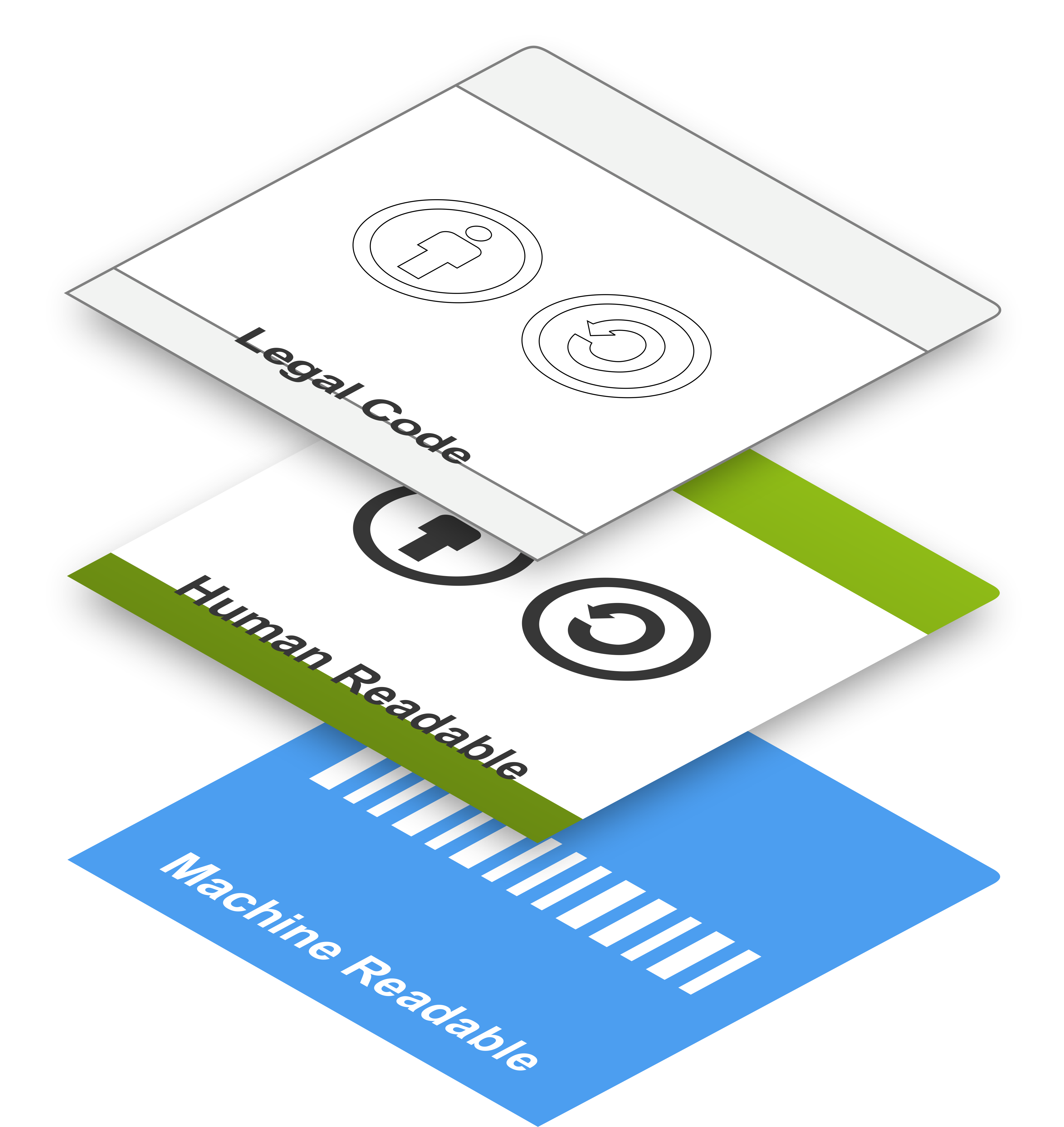







Your ability to use and OER is based on its Creative Commons license. These licenses give blank permission for everyone to use a work in ways defined by the author. Learning about the licenses will help you do more than simply reuse an OER...it will open the door to adaptation and publicly sharing your changes.
 Layers of a Creative Commons License
Layers of a Creative Commons LicenseCreative Commons licenses have three layers that make them incredible useful.
The basic parts of the licenses ensure that creators receive attribution for their work and then allows them to give permission for others to use the work when the conditions of the license are met.
"Three Layers of License" by Creative Commons, Nathan Yergler, Alex Roberts is licensed under CC BY 3.0 Unported.
Elements |
Meaning |
|
Attribution Every CC license includes the requirement for attribution. It states that users of CC works must given credit to the original creator of the work and to state any changes that have been made so other potential users can determine who they need to attribute. You can find information on how to give attribution here: https://creativecommons.org/use-remix/attribution/ |
|
|
NonCommercial When the NonCommercial element is represented, it prohibits the use of the work for commercial purposes. This specifically looks at how the work would be used. A picture with a NC license could be used by the for-profit company as a part of a decoration for an office party but it could not be used by a nonprofit organization as a picture in a book that is being sold. An important thing to remember is that while the work cannot be used commercially if you are using the work as a part of a CC license. Nothing prevents a potential commercial user to contact the creator for permission. |
|
|
ShareAlike ShareALlike states that if you create an adaption of the work, the adaption must be licensed under the same or compatible license. |
|
|
NoDerivatives By adding a NoDerivatives element to a license, the creator states that users cannot create adaptations of the work. This doesn't prevent the user from correcting spelling errors or changing the format of the work. |
Icon |
License |
Meaning |
|---|---|---|
 |
Attribution "CC BY" | Anyone can use and repurpose the work as long as they give attribution to the original creator and state any changes they made to the work. |
 |
Attribution-ShareAlike "CC BY-SA" | Anyone can create adaptations to the work as long as attribution is given and any adaptations that are shared publicly are shared with the same license. |
 |
Attribution-NonCommercial license "CC BY-NC" | The work is available for reuse and adaptations only non-profit purposes with attribution to the original author. |
 |
Attribution-NonCommerial ShareAlike "BY-NC-SA" | The work is available for reuse and adaptations only non-profit purposes with attribution to the original author as long as any adaptations are shared with the same license type. |
 |
Attribution-NoDerivatives "CC BY-ND" | The work can be shared but adaptations of the work cannot be shared publicly. |
 |
Attribution-NonCommercial-No-Derivatives "CC BY-NC-ND" | The work can be shared only for non-profit purposes but no adaptations are allowed. |
The Creative Commons was created to allow for the reuse and adaption of copyrighted works with a blanket license copyright owners can apply to their works. It does not impact the regular copyright exceptions and limitations already granted by copyright laws. For example, even if a work is given a BY-ND license that does not allow adaptions of a work, a parody of the work could be created as long as it is done using the Fair Use doctrine.
Since items in the public domain are not protected by copyright, there is no need to apply CC licenses to them. However, creators can dedicate their creations to the public domain and the Creative Commons has created an easy way for them to do so. Also, as the licenses have become common-place, the CC created a Public Domain mark that can be added to works already in the public domain to allow users to easily identify an item as available.
 This tool allows for a creator to state they no longer want any rights associated with their work and want to add it to the public domain. As some countries do not allow creators to give up their rights, a back up license is included with the legal code stating that anyone can do whatever they would like with the work.
This tool allows for a creator to state they no longer want any rights associated with their work and want to add it to the public domain. As some countries do not allow creators to give up their rights, a back up license is included with the legal code stating that anyone can do whatever they would like with the work.
 The public domain mark is a useful tool that people can add to works they know are in the public domain. Copyright laws can be confusing and by adding this mark, librarians and archivists let people know the work is not copyrighted.
The public domain mark is a useful tool that people can add to works they know are in the public domain. Copyright laws can be confusing and by adding this mark, librarians and archivists let people know the work is not copyrighted.
"Creative Commons Licensing" is a derivative of the September 2020 Creative Commons Certificate Course by Creative Commons, licensed CC BY 4.0. Kelly Kornkven adapted content from the Creative Commons Certificate Course Unit 3 on the Anatomy of a CC License by summarizing main points.
